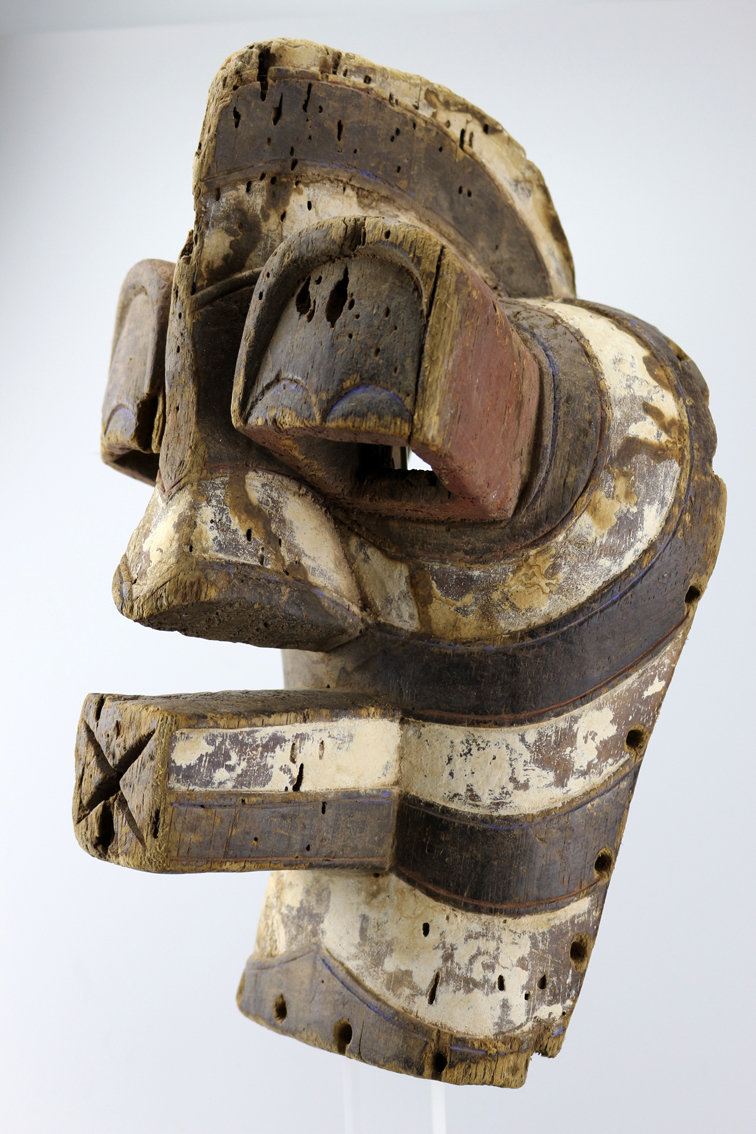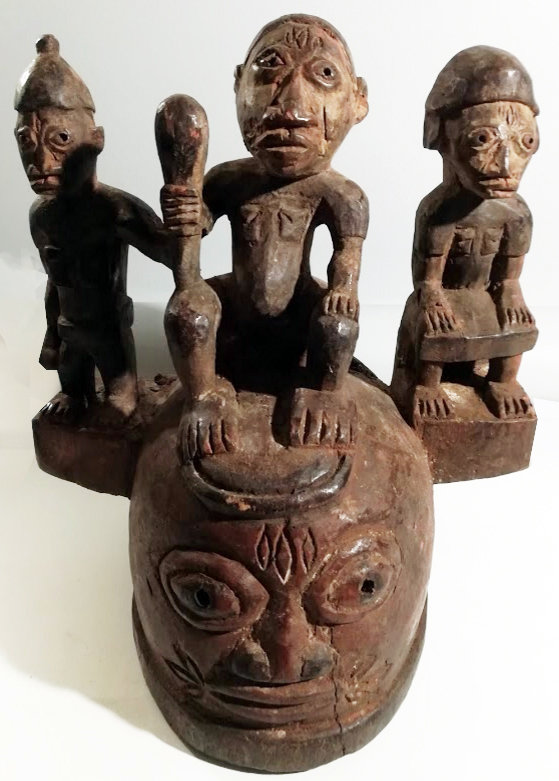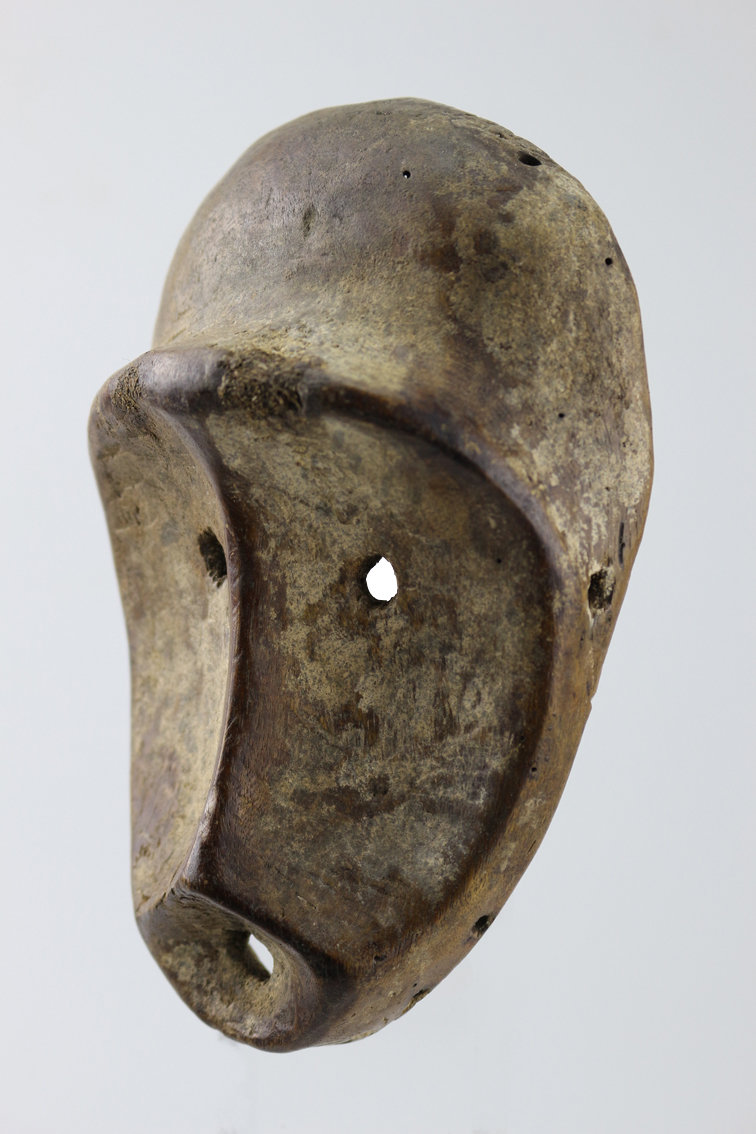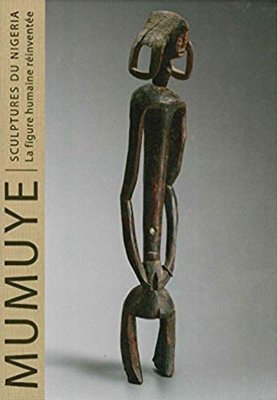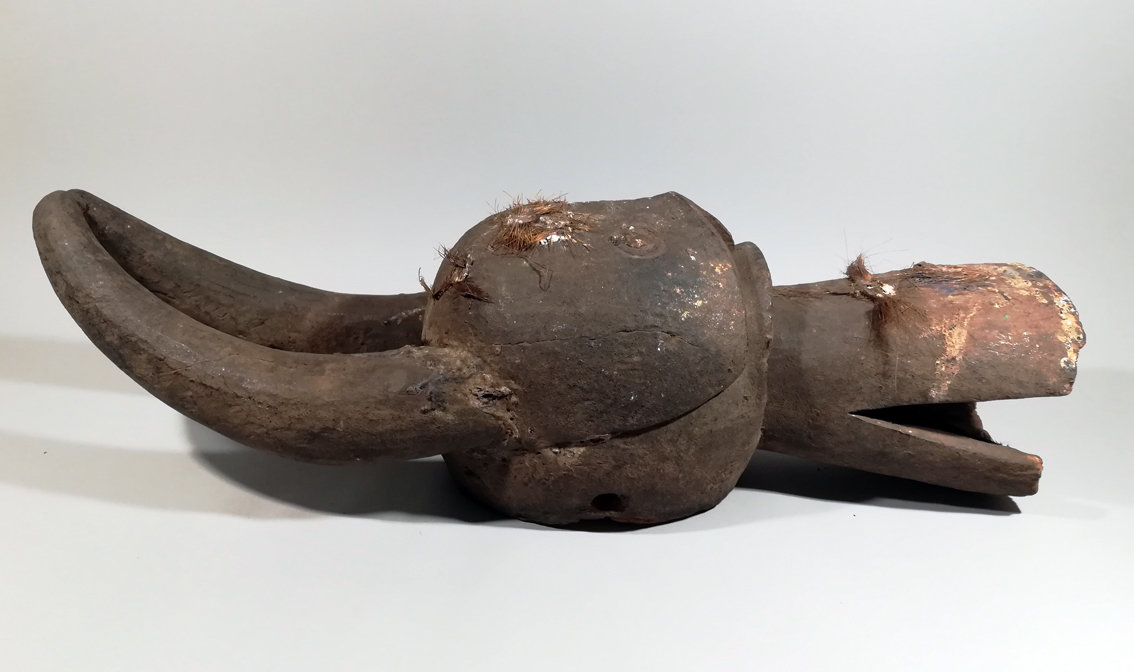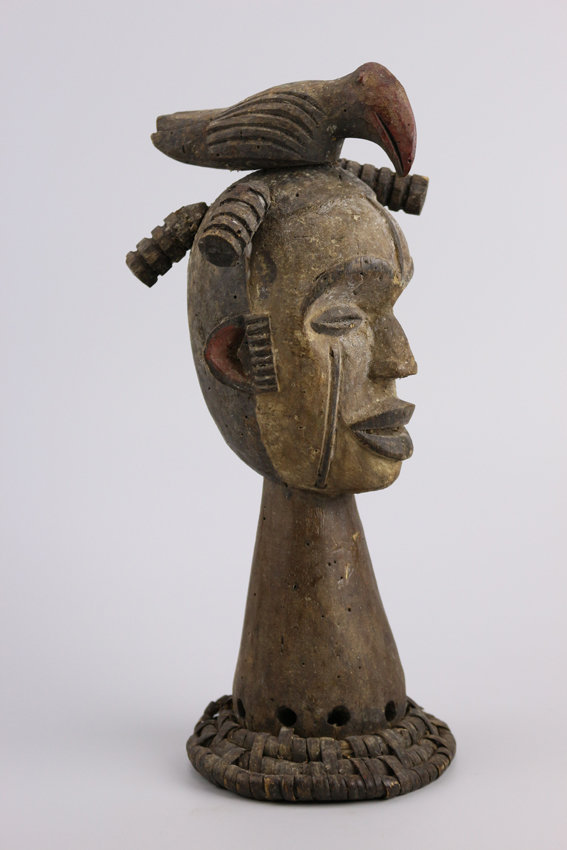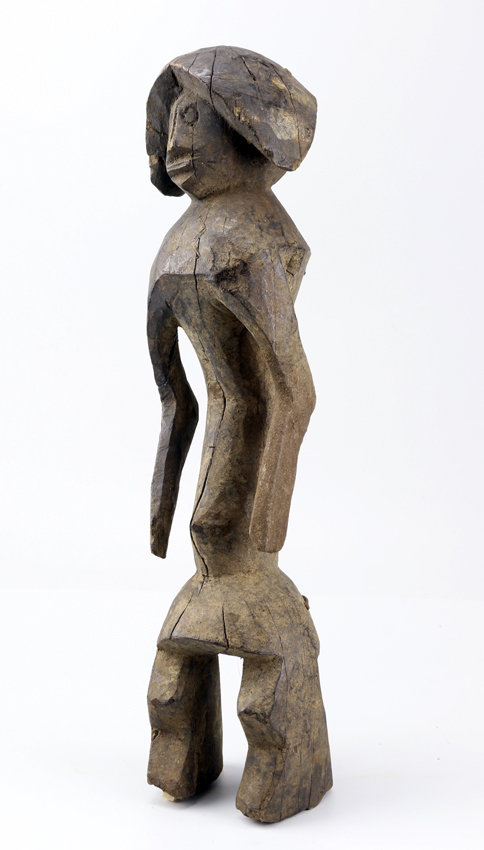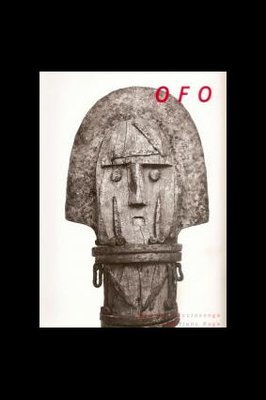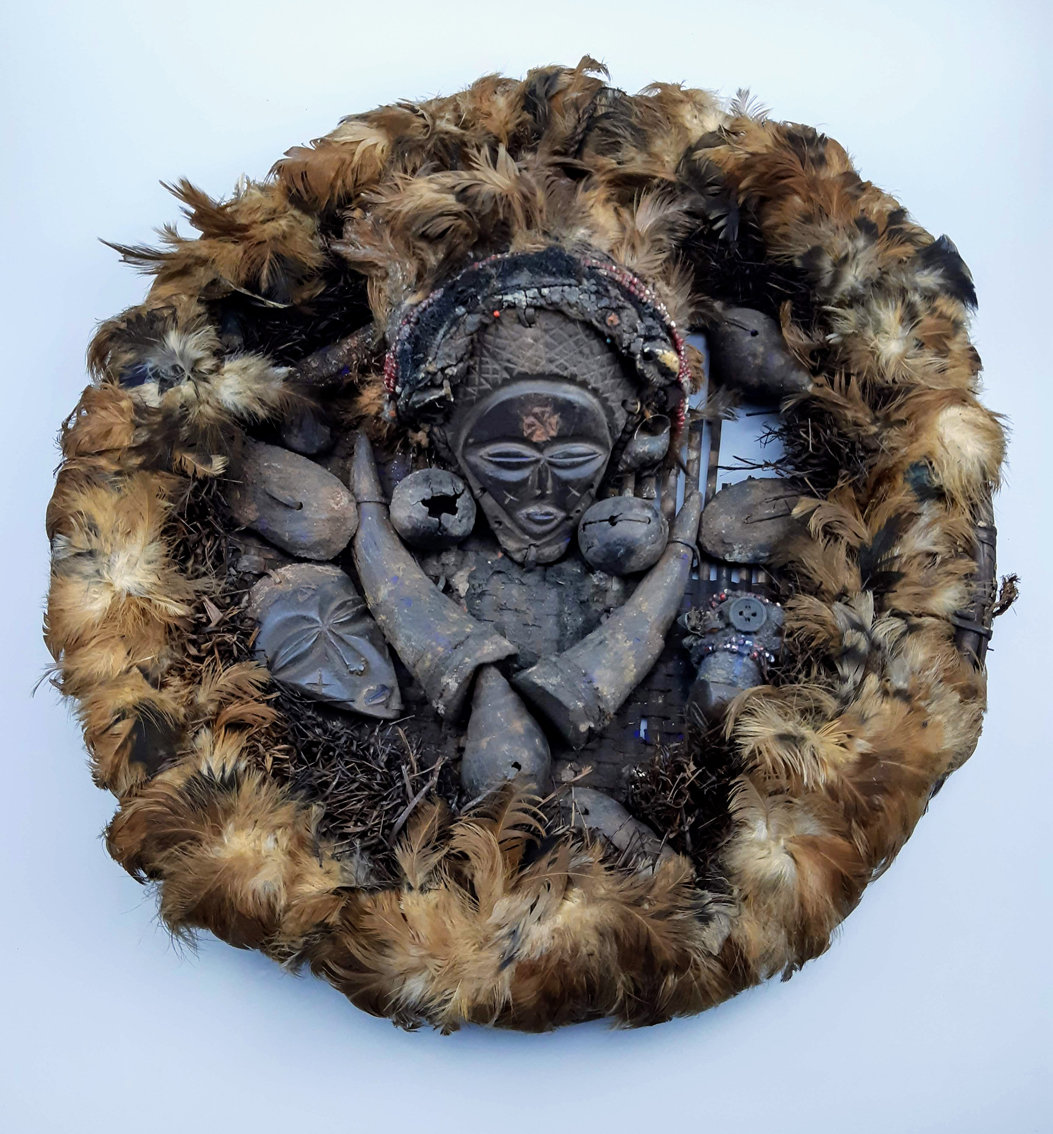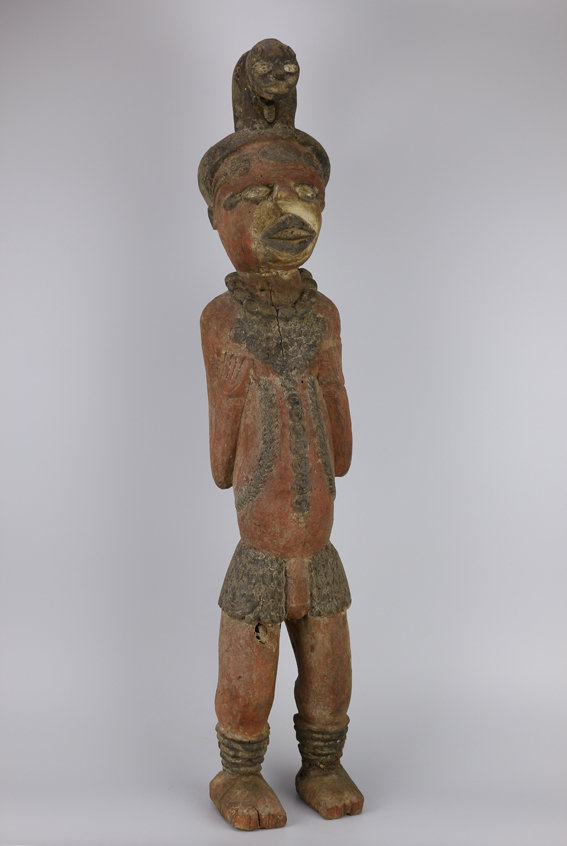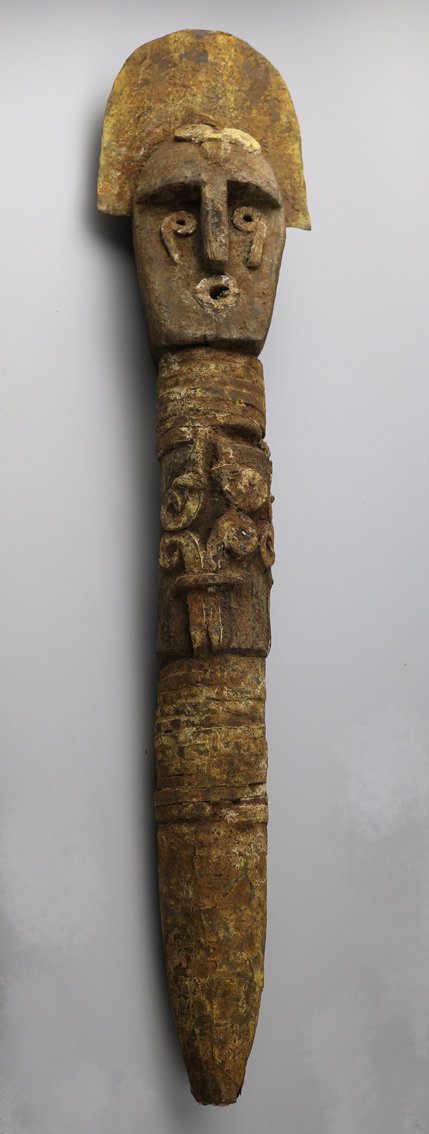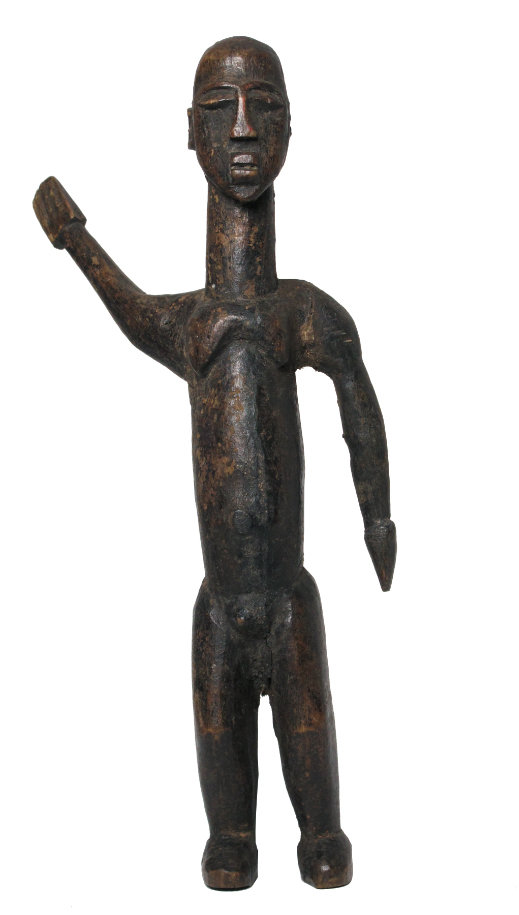-
Quick View€3,100.00
-
Quick View€1,100.00
-
Quick ViewMasquette Léga, République Démocratique du Congo
Bois, pigment de kaolin.La dimension des masquettes Léga n’excéde pas la paume de la main. Le type présenté ici fait partie des masques en bois qui participent au rite du lukwakongo. Son visage en forme de cœur, accentué par la présence de kaolin, met en valeur l’essentiel de la sculpture marquée par un nez droit et trois orifices ronds pour signifier les yeux et la bouche. Cette masquette est l’un des insignes les plus important des initiés du grade lutumbo Iwa yananio. Elle était maintenue sur le front ou le menton de l’initié ou pouvait être aussi fixée à une claie d’osier. La masquette symbolisait ainsi « la continuité au sein du Bwami et des groupes de parenté, une continuité qui lie les vivants aux morts » (Biebuyck, Lega, Ethique et beauté au cœur de l’Afrique. 2002. p. 71-72). Patine sombre d’usage.
***
Lega Maskette, Democratic Republic of the CongoWood, kaolin pigment.The size of the Léga masks does not exceed the palm of the hand. The type presented here is part of the wooden masks that participate in the rite of lukwakongo. Its heart-shaped face, accentuated by the presence of kaolin, highlights the essence of the sculpture marked by a straight nose and three round holes to signify the eyes and the mouth. This masquerade is one of the most important insignia of the initiates of lutumbo grade Iwa yananio. It was held on the forehead or chin of the initiate or could be attached to a wicker. The mask symbolized “the continuity within the Bwami and kinship groups, a continuity that binds the living to the dead” (Biebuyck, Lega, Ethics and beauty in the heart of Africa, 2002. pp. 71-72). Dark patina of use.
***
Masquette Lega, Demokratische Republik Kongo
Holz, Kaolinpigment.Die Größe der Léga-Masken übersteigt nicht die Handfläche. Der hier vorgestellte Typ ist Teil der Holzmasken, die am Ritus von Lukwakongo teilnehmen. Sein herzförmiges Gesicht, betont durch die Präsenz von Kaolin, unterstreicht die Essenz der Skulptur, die durch eine gerade Nase und drei runde Löcher gekennzeichnet ist, die die Augen und den Mund symbolisieren. Diese Maskerade ist eines der wichtigsten Insignien der Eingeweihten des lutumbo Grades Iwa yananio. Es wurde an der Stirn oder am Kinn des Eingeweihten gehalten oder konnte an einem Korb befestigt werden. Die Maske symbolisierte “die Kontinuität innerhalb der Bwami und Verwandtschaftsgruppen, eine Kontinuität, die die Lebenden mit den Toten verbindet” (Biebuyck, Lega, Ethik und Schönheit im Herzen Afrikas, 2002, S. 71-72). Dunkle Patina des Gebrauchs.
-
Quick View
It was not until the end of the 1960s that statues of the Mumuye culture in northeastern Nigeria appeared on the European art scene, but their impact was immediate and profound. Fans of African art were amazed to discover the abstract interpretation of the human body by the Mumuye, an interpretation which recalls the approach of anatomy by artists of the Cubist and Expressionist movements at the beginning of the 20th century. In addition, their anthropomorphic sculpted figures offer astonishing variations which testify to the very free creativity of these artists and their limitless inventiveness. A careful analysis of the extraordinary forms of these figures – which give off an incredible impression of movement – has led to the establishment of a stylistic classification which identifies different workshops, and even the hands of individual sculptors. In a summary of the rare studies carried out in the field, the book analyzes the essential role of these figures as symbols of a status and a social rank and their links with the veneration of the ancestors, but also their use in the healing practices. and divination. The work offers a selection of masks and other objects, but it focuses above all on the sculpted figures. By presenting around thirty masterpieces from public and private collections,
Mumuye: Sculptures from Nigeria, the human figure reinvented
By
-
Quick View€4,100.00
-
Quick View€2,600.00
Cameroon, Bamiléké – Dance mask
The Bamileke are a people of Central Africa, coming from Cameroon (West region) in the Grassland region where the Bamoun, Tikar also live, close to them by their common ancestors, their neighboring social structures and their languages. .
The work of D. Toukam (“History and anthropology of the Bamileke people”, Paris, L’Harmattan, 2010 and 2016; …) conclude that the Bamileke would most likely come from the Baladis of ancient Egypt (natives of Upper -Egypt). In Egypt, the current Feelahins / Copts are largely recognized as Baladis converted by force, but still retaining huge parts of their ancestral culture. Departing from Upper Egypt in the 9th century AD, the Baladis-Bamileke arrived in the Tikar region in the 12th century. They were neighbors of the Tikar, but were never descendants of Tikar, contrary to popular belief.
Les Bamilékés sont, en matière spirituelle, d’une grande complexité L’ensemble de leur organisation religieuse traditionnelle est composée de pratiques d’initiations, de méditations et de rituels.
Leur production d’objets liés à leurs différents cultes ont été d’une très grande richesse et certains cultes sont encore en cours de nos jours en exploitant d’anciens masques conservés dans certaines chefferies ou auprès de certains notables ou bien des pièces dites de “remplacement” créées pour remplacer les pièces anciennes usées, trop endommagées ou parce que l’usage en était limité dans le temps.
***
Cameroon, Bamiléké – Dance mask
The Bamileke are a people from Central Africa, coming from Cameroon (Western region) in the Grassland region where also Bamoun, Tikar, close to them by their common ancestors, their neighboring social structures and their languages live.
The works of D. Toukam (“History and Anthropology of the Bamileke People”, Paris, L’Harmattan, 2010 and 2016; …) conclude that the Bamileke would most probably come from the Baladis of ancient Egypt (indigenous of the Upper -Egypt). In Egypt, the current Feelahins / Copts are largely recognized as Baladis converted by force, but still retain huge portions of their ancestral culture. Part of Upper Egypt in the ninth century AD, Baladis-Bamileke arrived in the Tikar region in the twelfth century. They were Tikar neighbors, but were never descendants of Tikar, contrary to popular belief.
The Bamilékés are, in spiritual matter, of a great complexity The whole of their traditional religious organization is composed of practices of initiations, meditations and rituals.
Their production of objects related to their different cults have been of great wealth and some cults are still in use today using old masks preserved in some chieftaincies or with some notable or so-called pieces of ” replacement “created to replace worn old parts, too damaged or because the use was limited in time.
***
Kamerun, Bamiléké – Tanzmaske
Die Bamileke sind ein Volk von Zentralafrika, aus Kamerun (Western Region) in der Wiese Bereich, in dem auch Bamun die Tikar, in der Nähe, die sie von ihren gemeinsamen Vorfahren lebt, ihre Nachbarn und ihre soziale Strukturen Sprachen .
Die Arbeit von D. Toukam ( „Geschichte und Anthropologie der bamileke,“ Paris, L’Harmattan, 2010 und 2016 …) zu dem Schluss, dass Bamiléké würde höchstwahrscheinlich aus der Baladis des alten Ägyptens (Muttersprache Haut -Ägypten). In Ägypten Feelahins / Strom Kopten als Baladis umgewandelt gewaltsam weitgehend anerkannt, aber große Teile der Kultur ihrer Vorfahren beibehalten wird. Parteien von Oberägypten im neunten Jahrhundert nach Christus, der kamen Baladis-bamiléké in Tikar Region im zwölften Jahrhundert. Sie waren Tikars Nachbarn, waren aber, entgegen der landläufigen Meinung, niemals Nachkommen von Tikar.
Die Bamileke sind in geistlichen Dingen, von großer Komplexität Alle ihre traditionellen religiösen Organisation besteht aus Einweihungen Praktiken, Meditationen und Rituale.
Ihre Herstellung von Gegenständen im Zusammenhang mit ihren verschiedenen Kulten waren von großem Reichtum und einige Sekte sind noch heute Betreiber von alten Masken in einigen Stammesfürstentümer gehalten oder von einigen bemerkenswerten Teilentellenuuent, oder weil die Verwendung zeitlich begrenzt war.
-
Quick View€3,500.00
-
Quick View
Galerie l’Accrosonge & Editions Rage
Catalogue d’exposition Galerie l’Accrosonge, Paris, 2001
Auteurs : Espenel, Alexandre / Houdart, Rémi
96 pages, Grand in-8 broché, couverture illustrée. Photographies noir & blanc de Valérie Belin.
Ensemble exceptionnel d’Ofo, originaires des Ibo du Nigéria. -
Quick View€2,600.00
République Démocratique du Congo, Chokwé
Les Tchokwés sont un peuple bantou d’Afrique centrale et australe, surtout présent en République démocratique du Congo et en Angola, et à un moindre degré en Zambie. Quelques milliers vivent aussi en Namibie.
***
Democratic Republic of Congo, Chokwe
The Chokwe are a Bantu people from central and southern Africa, especially in the Democratic Republic of the Congo and Angola, and to a lesser extent in Zambia. A few thousand also live in Namibia.
***
Demokratische Republik Kongo, Chokwe
Die Chokwe sind ein Bantu-Volk aus dem zentralen und südlichen Afrika, insbesondere in der Demokratischen Republik Kongo und Angola, und in geringerem Maße auch in Sambia. Ein paar Tausend leben auch in Namibia. - Quick View
-
Quick View€4,000.00
Ofo, Igbo, Nigeria
In a cult universe rich in an extraordinary quantity of objects, Ofos sculptures from Nigeria seem to be by far the most important. Presumably composed from simple fetish twigs from a sacred tree, the Ofos have thus evolved to become objects or masks with immediately identifiable forms for those who have seen them at least once. Thus their artistic form was it built from the use of wood and iron but it also adapted to the imagination of each sculptor, the expected use of the Ofo as well as its native territory . A head of heavy wood, a metallic aura gives a body without a limb a most mystical look for long Ofos as well as Ofos formalized by their only head.
The Ofo presented here comes in the form of a particularly thin and slender body compared to those that are more commonly encountered. It also has the rare characteristic of having a double face sculpted and decorated with metallic irons on both sides of the aura. It is thus “januiform”. A strong pigmentation visible on the entire sculpture suggests an intense use for this emblematic object of authority and power.
Literature: ” OFO Anam, Regards sur un statuary Igbo “, Alexandre Espenel and Rémy Houdart. Editions Rage, 2001.
-
Quick View
Bateba statuette of the Lobi people, Burkina Faso
The Lobi live in southwestern Burkina Faso and northern Côte d’Ivoire and Ghana. they are extremely resistant to any form of centralized political authority. Instead their communities are based on the laws of God. The central figure in each Lobi community is the religious specialist named the Thildar. this soothsayer is responsible for communicating with the spirits that govern the community and protecting members of each family from accidents, illness, violence and all the multiple threats people encounter in the hostile environment of West Africa . The carved Lobi represent the spirits of nature they called Thil. Each of these figures displays different gestures or postures, some of them can have two or even three heads, some female figures carry a baby under the arm. These unique characteristics represent the particular talent or power of the spiritual being they embody. A figure raising an arm places a roadblock at the entrance of the malicious spirits at the family home.
H. 25cm. Male character whose pose reflects the Lobi aesthetic in its quality criteria. Standing, the right arm raised back, the left arm stretched out along the body. The forehead is high, the flat nose triangular and the male torso well pronounced. Sex and navel are prominent. The muscular legs have powerfully shaped calves. Hard and dense wood, very nice patina of use.
***
Bateba statuette of the Lobi people, Burkina Faso.
H. 25cm. Male character whose pose reflects the aesthetic Lobi in its quality criteria. Standing, the right brad raised back, the left arm at a distance stretched along the body. The forehead is high, the triangular flat nose and the pronounced male torso. Sex and navel are prominent. The muscular legs have powerful patterned knobs. Hard and dense wood, very beautiful patina of use.
***
Bateba Statuette der Lobi Leute, Burkina Faso.
H. 25cm. Männlicher Charakter, dessen Haltung den ästhetischen Lobi in seinen Qualitätskriterien widerspiegelt. Der rechte Brad hob sich zurück, der linke Arm streckte sich in einiger Entfernung über den Körper. Die Stirn ist hoch, die dreieckige flache Nase und der ausgeprägte männliche Torso. Sex und Nabel sind prominent. Die muskulösen Beine haben kräftige gemusterte Knöpfe. Hartes und dichtes Holz, sehr schöne Patina.
Recently added item(s)
